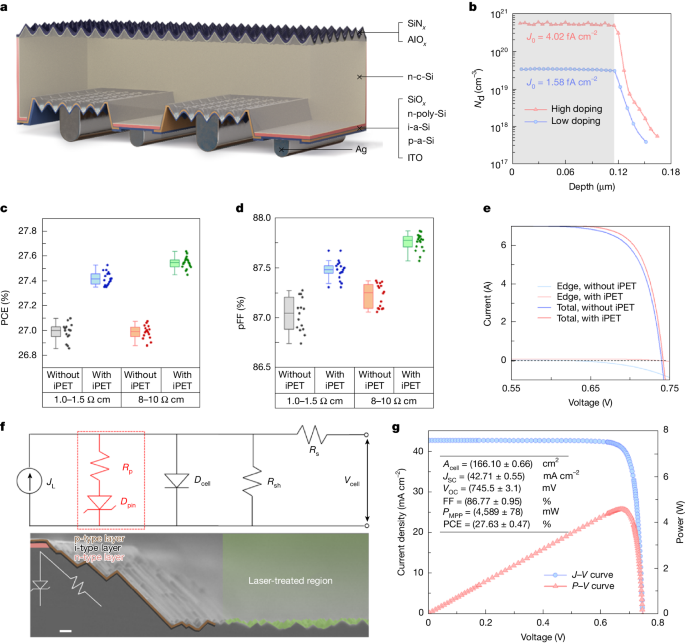Haegel, N. M. et al. Terawatt-scale photovoltaics: transform global energy. Science 364, 836–838 (2019).
Li, Z. Prospects of photovoltaic technology. Engineering 21, 28–31 (2023).
Allen, T. G. et al. Passivating contacts for crystalline silicon solar cells. Nat. Energy 4, 914–928 (2019).
Richter, A., Hermle, M. & Glunz, S. W. Reassessment of the limiting efficiency for crystalline silicon solar cells. IEEE J. Photovolt. 3, 1184–1191 (2013).
Green, M. A. et al. Solar cell efficiency tables (version 66). Prog. Photovolt. Res. Appl. 33, 795–810 (2025).
Blankenship, R. E. et al. Comparing photosynthetic and photovoltaic efficiencies and recognizing the potential for improvement. Science 332, 805–809 (2011).
Graus, W. H. J., Voogt, M. & Worrell, E. International comparison of energy efficiency of fossil power generation. Energy Policy 35, 3936–3951 (2007).
Green, M. A. Solar cell fill factors: general graph and empirical expressions. Solid State Electron. 24, 788–789 (1981).
Serenelli, L. et al. Selective contacts and fill factor limitations in heterojunction solar cells. Prog. Photovolt. Res. Appl. 29, 876–884 (2021).
Brendel, R. & Peibst, R. Contact selectivity and efficiency in crystalline silicon photovoltaics. IEEE J. Photovolt. 6, 1413–1420 (2016).
Shockley, W. The theory of p–n junctions in semiconductors and p–n junction transistors. Bell Syst. Tech. J. 28, 435–489 (1949).
Lin, H. et al. Silicon heterojunction solar cells with up to 26.81% efficiency achieved by electrically optimized nanocrystalline-silicon hole contact layers. Nat. Energy 8, 789–799 (2023).
McIntosh, K. Lumps, Humps and Bumps: Three Detrimental Effects in the Current–Voltage Curve of Silicon Solar Cells. PhD thesis, Univ. New South Wales, Sydney (2001).
Babbe, F., Choubrac, L. & Siebentritt, S. The optical diode ideality factor enables fast screening of semiconductors for solar cells. Sol. RRL 2, 1800248 (2018).
Wietler, T. F. et al. Pinhole density and contact resistivity of carrier selective junctions with polycrystalline silicon on oxide. Appl. Phys. Lett. 110, 253902 (2017).
Diggs, A. et al. Pinhole formation by nucleation-driven phase separation in TOPCon and POLO solar cells: structural dynamics and optimization. ACS Appl. Energy Mater. 7, 3414–3423 (2024).
Yoshikawa, K. et al. Silicon heterojunction solar cell with interdigitated back contacts for a photoconversion efficiency over 26%. Nat. Energy 2, 17032 (2017).
Tang, H. et al. Understanding localized current leakage in silicon-based heterojunction solar cells. Prog. Photovolt. Res. Appl. 33, 522–530 (2024).
Hamedani, Y. et al. in Chemical Vapor Deposition—Recent Advances and Applications in Optical, Solar Cells and Solid State Devices (ed. Sudheer N.) Ch. 10 (Intech Open Access, 2016).
Kanevce, A. & Metzger, W. K. The role of amorphous silicon and tunneling in heterojunction with intrinsic thin layer (HIT) solar cells. J. Appl. Phys. 105, 094507 (2009).
Wu, H. et al. Silicon heterojunction back-contact solar cells by laser patterning. Nature 635, 604–609 (2024).
Chichkov, B. N. et al. Femtosecond, picosecond and nanosecond laser ablation of solids. Appl. Phys. A 63, 109–115 (1996).
Procel, P. et al. The role of heterointerfaces and subgap energy states on transport mechanisms in silicon heterojunction solar cells. Prog. Photovolt. Res. Appl. 28, 935–945 (2020).
Qu, X. et al. Identification of embedded nanotwins at c-Si/a-Si:H interface limiting the performance of high-efficiency silicon heterojunction solar cells. Nat. Energy 6, 194–202 (2021).
Narayan, J., Young, R. T., Wood, R. F. & Christie, W. H. p–n junction formation in boron-deposited silicon by laser-induced diffusion. Appl. Phys. Lett. 33, 338–340 (1978).
Young, R. T., Narayan, J. & Wood, R. F. Electrical and structural characteristics of laser-induced epitaxial layers in silicon. Appl. Phys. Lett. 35, 447–449 (1979).
Köhler, M. et al. A silicon carbide-based highly transparent passivating contact for crystalline silicon solar cells approaching efficiencies of 24%. Nat. Energy 6, 529–537 (2021).
Ru, X. et al. Silicon heterojunction solar cells achieving 26.6% efficiency on commercial-size p-type silicon wafer. Joule 8, 1092–1104 (2024).
Green, M. A. The path to 25% silicon solar cell efficiency: History of silicon cell evolution. Prog. Photovolt. Res. Appl. 17, 183–189 (2009).
Feldmann, F. et al. Passivated rear contacts for high-efficiency n-type Si solar cells providing high interface passivation quality and excellent transport characteristics. Sol. Energy Mater. Sol. Cells 120, 270–274 (2014).
Su, Q. et al. Theoretical limiting-efficiency assessment on advanced crystalline silicon solar cells with Auger ideality factor and wafer thickness modifications. Prog. Photovolt. Res. Appl. 32, 587–598 (2024).
Cuevas, A. et al. Carrier population control and surface passivation in solar cells. Sol. Energy Mater. Sol. Cells 184, 38–47 (2018).
Aberle, A. G. Surface passivation of crystalline silicon solar cells: a review. Prog. Photovolt. Res. Appl. 8, 473–487 (2000).
Schmidt, J., Peibst, R. & Brendel, R. Surface passivation of crystalline silicon solar cells: present and future. Sol. Energy Mater. Sol. Cells 187, 39–54 (2018).
Hoex, B. et al. Ultralow surface recombination of c-Si substrates passivated by plasma-assisted atomic layer deposited Al2O3. Appl. Phys. Lett. 89, 042112 (2006).
Wang, G. et al. 27.09%-efficiency silicon heterojunction back contact solar cell and going beyond. Nat. Commun. 15, 8931 (2024).


